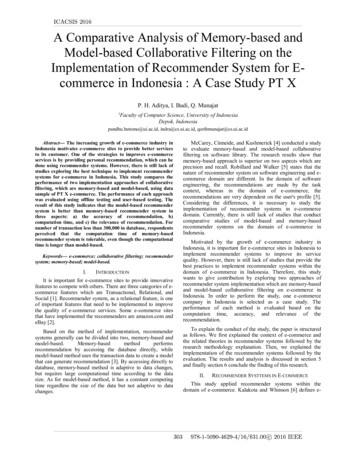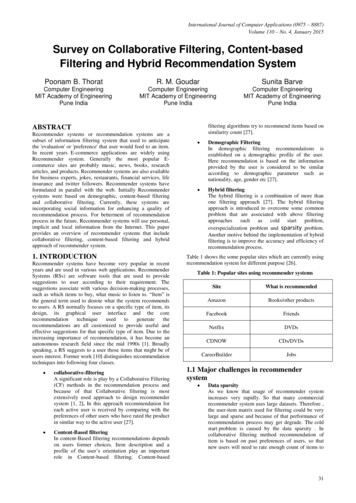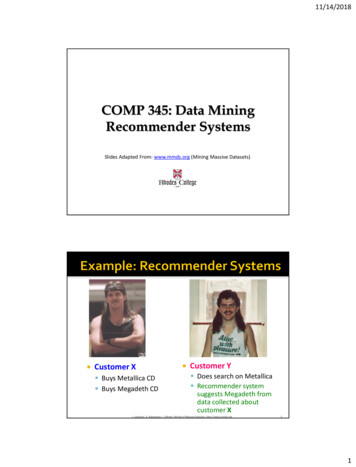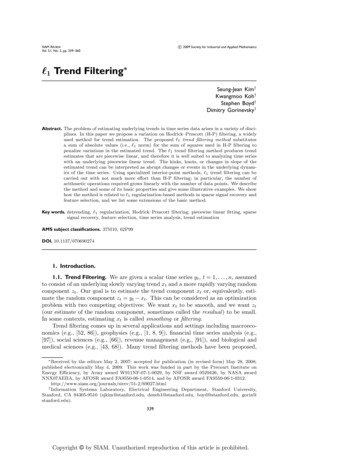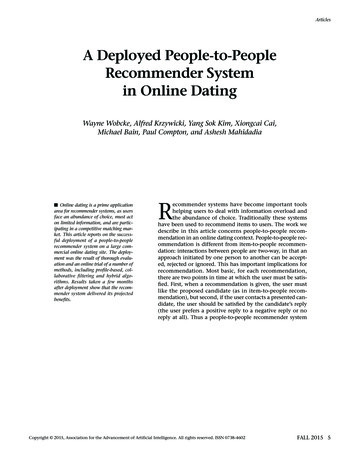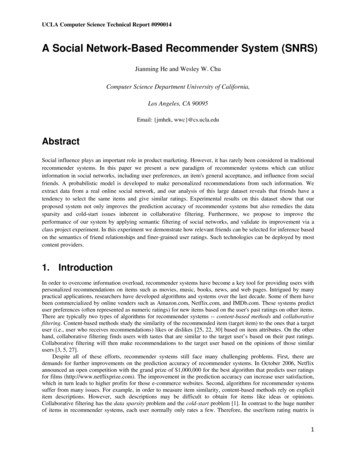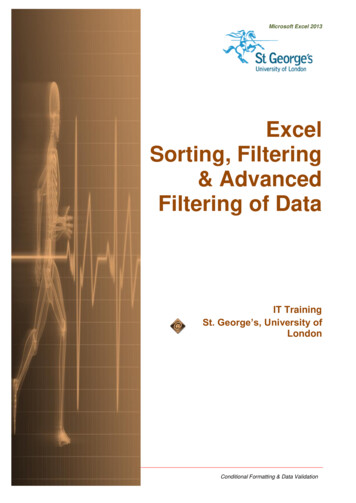
Transcription
Collaborative Filtering Recommender SystemsJ. Ben Schafer, Dan Frankowski, Jon Herlocker, and Shilad SenDepartment of Computer ScienceUniversity of Northern IowaCedar Falls, IA 50614-0507schafer@cs.uni.eduDepartment of Computer ScienceUniversity of Minnesota4-192 EE/CS Building200 Union St. SEMinneapolis, MN 55455{dfrankow , ssen } @ cs.umn.eduSchool of Electrical Engineering and Computer ScienceOregon State University102 Dearborn HallCorvallis, OR 97331herlock@eecs.oregonstate.eduAbstract. One of the potent personalization technologies powering theadaptive web is collaborative filtering. Collaborative filtering (CF) is theprocess of filtering or evaluating items through the opinions of other people. CFtechnology brings together the opinions of large interconnected communities onthe web, supporting filtering of substantial quantities of data. In this chapter weintroduce the core concepts of collaborative filtering, its primary uses for usersof the adaptive web, the theory and practice of CF algorithms, and designdecisions regarding design of rating systems and acquisition of ratings. Wealso discuss how to evaluate CF systems, and the evolution of rich interactioninterfaces. We close the chapter with discussions of the challenges of privacyparticular to a CF recommendation service and important open researchquestions in the field.1 IntroductionCollaborative Filtering is the process of filtering or evaluating items using theopinions of other people. While the term collaborative filtering (CF) has only beenaround for a little more than a decade, CF takes its roots from something humans havebeen doing for centuries - sharing opinions with others.For years, people have stood over the back fence or in the office break room anddiscussed books they have read, restaurants they have tried, and movies they haveseen – then used these discussions to form opinions. For example, when enough ofAmy’s colleagues say they liked the latest release from Hollywood, she might decide
2J. Ben Schafer, Dan Frankowski, Jon Herlocker, and Shilad Senthat she also should see it. Similarly, if many of them found it a disaster, she mightdecide to spend her money elsewhere. Better yet, Amy might observe that Mattrecommends the types of films that she finds enjoyable, Paul has a history ofrecommending films that she despises, and Margaret just seems to recommendeverything. Over time, she learns whose opinions she should listen to and how theseopinions can be applied to help her determine the quality of an item.Computers and the web allow us to advance beyond simple word-of-mouth.Instead of limiting ourselves to tens or hundreds of individuals the Internet allows usto consider the opinions of thousands. The speed of computers allows us to processthese opinions in real time and determine not only what a much larger communitythinks of an item, but also develop a truly personalized view of that item using theopinions most appropriate for a given user or group of users.1.1 Core ConceptsWhile this chapter considers a variety of CF systems, we introduce the topicthrough MovieLens1. MovieLens is a collaborative filtering system for movies. Auser of MovieLens rates movies using 1 to 5 stars, where 1 is “Awful” and 5 is “MustSee”. MovieLens then uses the ratings of the community to recommend other moviesthat user might be interested in (Figure 1), predict what that user might rate a movie,or perform other tasks.Figure 1: MovieLens uses collaborative filtering to predict that this user is likelyto rate the movie “Holes” 4 out of 5 stars.1http://www.movielens.org/
Collaborative Filtering Recommender Systems3To be more formal, a rating consists of the association of two things – user anditem. One way to visualize ratings is as a matrix (Table 1). Without loss of generality,a ratings matrix consists of a table where each row represents a user, each columnrepresents a specific movie, and the number at the intersection of a row and a columnrepresents the user’s rating value. The absence of a rating score at this intersectionindicates that that user has not yet rated the item.Table 1: A MovieLens ratings matrix. Amy rated the movie Sideways a 5. Matt has not seenThe Matrix.AmyMattPaulCliffThe The term user refers to any individual who provides ratings to a system. Mostoften, we use this term to refer to the people using a system to receive information(e.g., recommendations) although it also refers to those who provided the data(ratings) used in generating this information.CF systems determine the quality of items. Items can consist of anything for whicha human can provide a rating, such as art, books, CDs, journal articles, or vacationdestinations.Ratings in a collaborative filtering system can take on a variety of forms. Scalar ratings can consist of either numerical ratings, such as the 1-5stars provided in MovieLens or ordinal ratings such as strongly agree,agree, neutral, disagree, strongly disagree. Binary ratings model choices between agree/disagree or good/bad. Unary ratings can indicate that a user has observed or purchased an item,or otherwise rated the item positively. The absence of a rating indicatesthat we have no information relating the user to the item (perhaps theypurchased the item somewhere else).Ratings may be gathered through explicit means, implicit means, or both. Explicitratings are those where a user is asked to provide an opinion on an item. Implicitratings are those inferred from a user’s actions. For example, a user who visits aproduct page perhaps has some interest in that product while a user who subsequentlypurchases the product may have a much stronger interest in that product. The issues ofdesign decisions and tradeoffs regarding collection of different types of ratings arediscussed in Section 4.
4J. Ben Schafer, Dan Frankowski, Jon Herlocker, and Shilad Sen1.2 The Beginning of Collaborative FilteringAs a formal area of research, collaborative filtering got its start as a means tohandle the shifting nature of text repositories. As content bases grew from mostly"official" content, such as libraries and corporate document sets, to "informal" contentsuch as discussion lists and e-mail archives, the challenge of finding quality itemsshifted as well. Pure content-based techniques were often inadequate at helping usersfind the documents they wanted. Keyword-based representations could do anadequate job of describing the topic of documents, but could do little to help usersunderstand the nature or quality of those documents. Hence, a keyword search for“Chicago Rocks” might yield not only scholarly articles by the Chicago Rocks andMinerals Society but also the “shallower” posting to a music bulletin board regardingthe 1970s rock band.In the early 1990s there seemed to be two possible solutions to this new challenge:1. wait for improvements in artificial intelligence that would allow better automatedclassification of documents, or2. bring human judgment into the loop.While the challenges of automated classification have yet to be overcome, humanjudgment has proved valuable and relatively easy to incorporate into semi-automatedsystems2.The Tapestry system, developed at Xerox PARC, took the first step in thisdirection by incorporating user actions and opinions into a message database andsearch system [17]. Tapestry stored the contents of messages, along with metadataabout authors, readers, and responders. It also allowed any user to store annotationsabout messages, such as "useful survey" or "Phil should see this!" Tapestry userscould form queries that combined basic textual information (e.g. contains the phrase"recommender systems") with semantic metadata queries (e.g. written by John ORreplied to by Joe) and annotation queries (e.g. marked as "excellent" by Chris). Thismodel has become known as pull-active collaborative filtering, because it is theresponsibility of the user who desires recommendations to actively pull therecommendations out of the database.Soon after the emergence of Tapestry, other researchers began to recognize thepotential for exploiting the human "information hubs" that seem to naturally occurwithin organizations. Maltz and Ehrlich [37] developed a push-active collaborativefiltering recommender system that made it easy for a person reading a document topush that document on to others in the organization who should see it. This type ofpush-recommender role has become popular, with many people today serving as "jokehubs" who receive jokes from all over and forward them to those they believe wouldappreciate them (though often with far less discriminating thought than wasenvisioned).A limitation of active collaborative filtering systems is that they require acommunity of people who know each other. Pull-active systems require that the user2For a slightly more broad discussion on the differences between collaborative filtering andcontent filtering, see Section 2.4 of this chapter.
Collaborative Filtering Recommender Systems5know whose opinions to trust; push-active systems require that the user know towhom particular content may be interesting. Automated collaborative filtering (ACF)systems relieve users of this burden by using a database of historical user opinions toautomatically match each individual to others with similar opinions.The early ACF systems included GroupLens [46,30] in the domain of Usenetnewsgroup articles, Ringo [52] in the domain of music and musical artists, andBellcore’s Video Recommender [24] in the domain of movies. While a more formaldiscussion of recommendation algorithms follows in Section 3, each of these systemsfollow a process of gathering ratings from users, computing the correlations betweenpairs of users to identify a user’s “neighbors” in taste space, and combining theratings of those neighbors to make recommendations. GroupLens used a very explicitinterface where ratings of Usenet newsgroup articles were entered manually bykeystroke or button, and ratings were displayed numerically or graphically (Figure 2).Taking this a step further, both Ringo and Video Recommender were accessiblethrough the web and email and provided simple features for community interaction.Figure 2: A modified Xrn news reader. The GroupLens project added articlepredictions (lines of ### on the top right) and article rating buttons (bottom).
6J. Ben Schafer, Dan Frankowski, Jon Herlocker, and Shilad Sen1.3 Collaborative Filtering and the Adaptive WebThese early collaborative filtering systems were designed to explicitly provideusers with information about items. That is, users visited a website for the purpose ofreceiving recommendations from the CF system. Later, websites began to use CFsystems behind the scenes to adapt their content to users, such as choosing whichnews articles a website should be presenting prominently to a user.Providers of information on the web must deal with limited user attention andlimited screen space. Collaborative filtering can predict what information users arelikely to want to see, enabling providers to select subsets of information to display inthe limited screen space. By placing that information prominently, it enables the userto maximize their limited attention. In this way, collaborative filtering enables theweb to adapt to each individual user’s needs.The remainder of this chapter will discuss collaborative filtering in more depth byconsidering: The tasks for which users might use a CF system, things a CF system is good at,and the kinds of domains for which CF is appropriate (Section 2) Algorithms that CF systems employ (Section 3) How types of ratings in a CF system affect design choices (Section 4) How to evaluate and compare recommenders (Section 5) Trends in the development of more interactive and explicitly social interfaces(Section 6) The challenges to privacy and trust within CF systems (Section 7) Open questions in the continuing development of CF systems (Section 8)2 Uses For Collaborative FilteringThus far, we have only briefly introduced collaborative filtering systems.However, we may have still left readers asking the question “for what purposes is CFappropriate?” In this section we consider this question by exploring user tasks thatCF supports, then the services that CF systems provide, and finally, contrasting CFwith content filtering, a technique that supports many of the same tasks, but usingdifferent technology. Throughout, we explore both well-understood technologies, andthought-provoking proposals that are not as well understood.2.1 User TasksDesigners of adaptive websites should carefully identify the possible tasks usersmay wish to accomplish with their site as different tasks may require different designdecisions. From a marketing perspective, this is the value added by the CF system. Inthis section, we consider user tasks for which collaborative filtering is useful.Tasks for which people use collaborative filtering that have been studied include:
Collaborative Filtering Recommender Systems71. Help me find new items I might like. In a world of information overload, I cannotevaluate all things. Present a few for me to choose from. This has been appliedmost commonly to consumer items (music, books, movies), but may also beapplied to research papers, web pages, or other ratable items.2. Advise me on a particular item. I have a particular item in mind; does thecommunity know whether it is good or bad?3. Help me find a user (or some users) I might like. Sometimes, knowing who tofocus on is as important as knowing what to focus on. This might help withforming discussion groups [34], matchmaking, or connecting users so that they canexchange recommendations socially.4. Help our group find something new that we might like. CF can help groups ofpeople find items that maximize value to group as a whole [41]. For example, acouple that wishes to see a movie together or a research group that wishes to readan appropriate paper.5. Domain-specific tasks. For example, a research paper recommender [55] mightalso wish to supporta) recommend papers that this paper should citeb) recommend papers that should cite this paperMoreover, there are likely many tasks that are still undiscovered. Others are not yetwell documented in the research literature, although they could be supported by theratings data that collaborative filtering often has available. For example:6. Help me find an item, new or not. For example, I might wish a “balanced diet” ofrestaurants, including ones I’ve gone to before; or, I might wish to go to arestaurant with a group of people, even if some have already been there; or, I mightwish to purchase some groceries that are appropriate for my shopping cart, even ifI’ve already bought them before.7. Domain-specific tasks. For example, a recommender for a movie and a restaurantfor 1) a first date versus 2) a guys’ night out.Note that “domain-specific tasks” are on both lists. Recommenders for somedomain-specific tasks have been explored; many have not. To date, much research hasfocused on more abstract tasks (like “find new items”) while not probing deeply intothe underlying user goals (like “find a movie for a first date”).2.2 Collaborative Filtering System FunctionalityThere are also broad abstract families of tasks that CF systems support. It is noaccident that this system functionality is related to the user tasks of the previoussection. Ideally, the system would support all user tasks, although mapping a realapplication to the functionality of an actual CF system can be challenging. In anycase, here are the broad families of common CF system functionality:1. Recommend items. Show a list of items to a user, in order of how useful theymight be. Often this is described as predicting what the user would rate the item,
8J. Ben Schafer, Dan Frankowski, Jon Herlocker, and Shilad Senthen ranking the items by this predicted rating. However, some successfulrecommendation algorithms do not compute predicted rating values at all. Forexample, Amazon’s recommendation algorithm aggregates items similar to a user’spurchases and ratings without ever computing a predicted rating [33]. Instead ofdisplaying a personalized predicted rating, their user interface displays the averagecustomer rating. As a result, the recommendation list may appear out of order withrespect to the displayed average rating value. In many applications, picking the topfew items well is crucial; producing predicted values is secondary.2. Predict for a given item. Given a particular item, calculate its predicted rating.Note that prediction can be more demanding than recommendation. To recommenditems, a system only needs to be prepared to offer a few alternatives, but not all.Some algorithms take advantage of this to be more scalable by saving memory andcomputation time [33, 47]. To provide predictions for a particular item, a systemmust be prepared to say something about any requested item, even rarely ratedones. How does a system decide how a particular user would rate a requested itemif very few users – let alone users similar to the particular user – have rated theitem? Personalized predictions may be challenging, if not impossible.3. Constrained recommendations: Recommend from a set of items. Given aparticular set or a constraint that gives a set of items, recommend from within thatset. For example:“Consider the following scenario. Mary's 8-year-old nephew is visitingfor the weekend, and she would like to take him to the movies. Shewould like a comedy or family movie rated no "higher" than PG-13.She would prefer that the movie contain no sex, violence or offensivelanguage, last less than two hours and, if possible, show at a theater inher neighborhood. Finally, she would like to select a movie that sheherself might enjoy.” [50]Schafer et al. [50] propose a “meta-recommendation system” that generatesrecommendations from a blending of multiple recommendation sources.Users define preferences and requirements through a web form that restrictsthe set of potential candidate items. Recommendations are based on aranking of how well the items within this set match the provided preferences.Adomavicius et al. [1] call this “flexibility,” and propose a SQL-likelanguage as a desired extension in a “next-generation” recommendationsystem. Such a system might accept queries such as “RECOMMEND MovieTO User BASED ON Rating FROM MovieRecommender WHEREMovie.Length 120 AND Movie.Rating 3 AND User.City Movie.Location.” Similar techniques are discussed in Chapter AT7 [53].2.3 Suitable domains for collaborative filteringOne might simply take a user application, implement it with a CF system, and hopeit will work. However, CF is better known to be effective in domains with certainproperties. It seems useful to acquaint ourselves with them, and consider whether the
Collaborative Filtering Recommender Systems9user application is a good fit. We group these properties below into data distribution,underlying meaning, and data persistence.Note that with special consideration, CF can be successfully applied in domainsthat do not have some of the properties below. We simply list them to provokethought and discussion about what domains are easy or hard with collaborativefiltering.Data distribution. These properties are about the numbers and shape of the data:1. There are many items. If there are only a few items to choose from, the user canlearn about them all without need for computer support.2. There are many ratings per item. If there are only a few ratings per item, theremay not be enough information to provide useful predictions or recommendations.3. There are more users rating than items to be recommended. A corollary of theprevious paragraph is that often you’ll need more users than the number of itemsthat you want to be able to capably recommend. More precisely, if there are fewratings per user, you’ll need many users. Lots of systems are like this. For example,this makes web pages a challenging domain, especially if the system requiresexplicit ratings. Google3, a popular search engine, claims to index 8 billion webpages at present, which is more than the number of people in the world, not tomention the number who have access to computers. As another example, with onemillion users, a CF system might be able to make recommendations for a hundredthousand items, but may only be able to make confident predictions for tenthousand or fewer, depending on the distribution of ratings across items. Theratings distribution is almost always very skewed: a few items get most of theratings, a long tail of items that get few ratings. Items in this long tail will not beconfidently predictable.4. Users rate multiple items. If a user rates only a single item, this provides someinformation for summary statistics, but no information for relating the items toeach other.Underlying meaning. These properties are of the underlying meaning of the data:1. For each user of the community, there are other users with common needs ortastes. CF works because people have needs or tastes in common. If a person hastastes so unique that they are not shared by anybody else, then CF cannot provideany value. More generally, CF works better when each user can find many otherusers who share their tastes in some fashion.2. Item evaluation requires personal taste. In cases where there are objectivecriteria for goodness that can be automatically computed, those criteria may bebetter applied by means other than collaborative filtering, e.g., search algorithms.Collaborative filtering allows users with similar tastes to inform each other. CFadds substantial value when evaluation of items is largely subjective (e.g., music),or when those items have many different objective criteria that need to besubjectively weighed against each other (e.g., cars). Sometimes there are objectivecriteria that can help (e.g., only recommend books written in English), but if3http://www.google.com/
10J. Ben Schafer, Dan Frankowski, Jon Herlocker, and Shilad Senrecommendation can be performed using only objective criteria, then CF is notuseful.3. Items are homogenous. That is to say, by all objective consumption criteria theyare similar, and they differ only in subjective criteria. Music albums are like this.Most are similarly priced, similar to buy, of a similar length. Books or researchpapers are also like this. Items sold at a department store are not like this: some arecheap, some very expensive. For example, if you buy a hammer, perhaps youshould not be recommended a refrigerator.Data persistence. These are properties of how long the data is relevant:1. Items persist. Not only does a CF system need a single item to be rated by manypeople, but also requires that people share multiple rated items – that there isoverlap in the items they rate. If I’ve rated item A and I want a prediction for itemB, most CF algorithms require multiple users to have rated both A and B. If I’verated item A and I want recommendations, most CF algorithms require thatmultiple users have rated A and some other items. All of this means that if itemsare only important for a short time, these requirements are hard to meet. Forexample, news stories: many appear per day, and many probably are onlyinteresting for a few days.2. Taste persists. CF has been most successful in domains where users’ tastes don’tchange rapidly: e.g., movies, books, and consumer electronics. If tastes changefrequently or rapidly, then older ratings may be less useful. An example might beclothing, where someone’s taste from five years ago may not be relevant.The properties of the preceding sections represent simplifications of the worldwhere CF is most easily applied. In fact, applying CF in domains where theseproperties do not hold can provide both interesting applications and interestingresearch areas. For example, one might try to apply CF to non-homogenous items byusing constrained recommendations, or applying external constraints (called businessrules in the business world). Likewise, in order to perform system tasks for nonpersistent items, one might try to apply content filtering, which is explored in the nextsection.2.4 Comparing collaborative filtering to content-based filteringCollaborative filtering uses the assumption that people with similar tastes will ratethings similarly. Content-based filtering uses the assumption that items with similarobjective features will be rated similarly. For example, if you liked a web page withthe words “tomato sauce,” you’ll like another web page with the words “tomatosauce.” The challenge is to cleanly extract the features of items that are mostpredictive. One then builds a user profile of features from the items a user has rated,and then compares that user profile to item profiles of new items whose features areextracted [4]. For more information, refer to Chapter AT5 [43].Content-based filtering and collaborative filtering have long been viewed ascomplementary [1]. Content-based filtering can predict relevance for items without
Collaborative Filtering Recommender Systems11ratings (e.g., new items, high-turnover items like news articles, huge item spaces likeweb pages); collaborative filtering needs ratings for an item in order to predict for it.On the other hand, content-based filtering needs content to analyze, and content canbe scarce in some domains (e.g., movies, music, restaurants, and books without textreviews available); collaborative filtering does not require content. A content filteringmodel can only be as complex as the content it has access to. For instance, if thesystem only has genre metadata for movies, the model can only incorporate this oneextremely coarse dimension. Furthermore, if there is no easy way to automaticallyextract a feature, then content-based filtering cannot consider that feature. Forexample, while people find the quality of multimedia data (e.g., images, video, oraudio) for web pages important, it is difficult to automatically extract this information[4]. Collaborative filtering allows evaluation of such features, because people aredoing the evaluating.Content-based filtering may over-specialize. Items are recommended that matchthe content features in the user's interest profile or query. Items that do not contain theexact features specified in the interest profile may not get recommended even if theyare similar (e.g., due to synonymy in keyword terms). Researchers generally believecollaborative filtering leads to more unexpected or different items that are equallyvaluable. Some people call this property of recommendations novelty orserendipity[21]. (See 1.6.2 for a more complete discussion.) However, collaborativefiltering has also been shown to over-specialize in some cases [57].Content-based filtering (CBF) and collaborative filtering may be manuallycombined by the end-user specifying particular features, essentially constrainingrecommendations to have certain content features [50]. More often they areautomatically combined, sometimes called a hybrid approach. There are many waysto combine them, and no consensus exists among researchers [5, 11, 12, 19, 44].However, such systems generally use the content analysis to identify items that meetthe immediate need of the user, and use CF to try and capture features like quality thatare hard to automatically analyze. For a more detailed look at these techniques, referto Chapter AT6 [9].3 Collaborative Filtering Algorithms: Theory and PracticeOver the past decade, collaborative filtering algorithms have evolved from researchalgorithms intuitively capturing users’ preferences to algorithms that meet theperformance demands of large commercial applications. In this section we exploresome of the most widely known collaborative filtering algorithms. Although a gooddeal of theoretical literature describes CF algorithms, little information is available toassist practitioners in building CF systems. We highlight not only the theoreticaldefinition of these algorithms but their practical challenges and, where applicable,suggest techniques to address these challenges.Breese et al. [8] described CF algorithms as separable into two classes: memorybased algorithms that require all ratings, items, and users be stored in memory andmodel-based algorithms that periodically create a summary of ratings patterns offline.Pure memory-based models do not scale well for real-world application. Thus,
12J. Ben Schafer, Dan Frankowski, Jon Herlocker, and Shilad Senalmost all practical algorithms use some form of pre-computation to reduce run-timecomplexity. As a result, current practical algorithms are either pure model basedalgorithms or are a hybrid of some pre-computation combined with some ratings datain memory.A more useful organization of collaborative filtering algorithms splits them intonon-probabilistic algorithms and probabilistic algorithms. We consider algorithms tobe probabilistic if they are based on an underlying probabilistic model. That is, theyrepresent probability distributions when computing predicted ratings or rankedrecommendation lists. In general, non-probabilistic models are widely used bypractitioners. Probabilistic models have been gaining favor, however, particular inthe machine learning community.3.1 Non-probabilistic AlgorithmsThe most well-known CF algorithms are nearest neighbor algorithms. Weintroduce the two different classes of nearest neighbor CF algorithms: user-basednearest neighbor and item-based nearest neighbor. We also explore more briefly nonprobabilistic algorithms that transform or cluster the ratings space to reduce theratings space dimensionality. Other commonly cited algorithms not discussed hereinclude graph-based algorithms [2], neural networks [7], and rule-mining algorithms[20].User-based Nearest Neighbor AlgorithmsEarly algorithms generated predictions for users based on ratings from similarus
Collaborative Filtering is the process of filtering or evaluating items using the opinions of other people. While the term collaborative filtering (CF) has only been around for a little more than a decade, CF takes its roots from something humans have been doing for centuries - sharing opinions with others.
